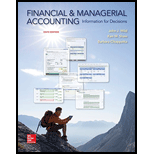
Concept explainers
Asset:
Asset may be regarded as a resource for the person or entity which holds it with a specific economic value and the benefits derived from such asset are generally divided over the lifespan of such asset .Also, they are held to reap some future benefits on account of pooling the funds at present. An asset may be in tangible or intangible form depending upon the nature of asset.
Equity:
An ownership interest in any kind of security or it may also be regarded as the difference value of the assets held and liabilities against the said assets. Also, in the financial statement of the company the funds contributed by the owners and any of the retained or ploughed back earnings (or losses) are regarded as shareholder's equity.
Liability:
A liability may be regarded as the burden or it depicts the obligatory aspect related to a transaction and that it is to be fulfilled in the near future. They mainly form part of the financial statements so that the end users may analyze the current standing of the entity in terms of its liabilities against the possession of its assets.
The items that best completes the descriptions below.
Want to see the full answer?
Check out a sample textbook solution
Chapter 2 Solutions
Financial and Managerial Accounting: Information for Decisions
- General accounting questionsarrow_forwardQuestion: Power Security Systems had sales of 3,000 units at $50 per unit last year. The marketing manager projects a 20 percent increase in unit volume sales this year with a 10 percent price increase. Returned merchandise will represent 6 percent of total sales. What is your net dollar sales projection for this year? Help mearrow_forwardI am searching for the correct answer to this general accounting problem with proper accounting rules.arrow_forward
- Please provide correct answerarrow_forwardReciprocal Method Eilers Company has two producing departments and two support departments. The following budgeted data pertain to these four departments: Support Departments Producing Departments General Factory Receiving Assembly Finishing Direct overhead $400,000 $150,000 $45,000 $71,000 Square footage 2,700 5,400 5,400 Number of receiving orders 300 1,680 1,020 Direct labor hours 25,000 40,000 Required: 1. Allocate the overhead costs of the support departments to the producing departments using the reciprocal method. (Round allocation ratios to two decimal places. Round allocated costs to the nearest dollar. If an amount is zero, enter "0".) Allocation ratios: Square footage General Factory Receiving Assembly Finishing 0 0 Number of receiving orders 0.10 0 0.56 0.34 Allocations: Direct overhead cost General Factory Receiving Total General Factory Receiving Assembly Finishing $ $ $ $ 400,000 150,000 45,000 71,000 $ $ $ $ 2. Using direct labor hours, compute departmental overhead…arrow_forwardReciprocal Method of Support Department Cost Allocation Valron Company has two support departments, Human Resources and General Factory, and two producing departments, Fabricating and Assembly. Direct costs Normal activity: Number of employees Square footage Support Departments Producing Departments Human Resources $140,000 General Factory $340,000 Fabricating Assembly $114,200 $94,000 1,000 60 80 170 5,700 13,300 The costs of the Human Resources Department are allocated on the basis of number of employees, and the costs of General Factory are allocated on the basis of square footage. Now assume that Valron Company uses the reciprocal method to allocate support department costs. Required: 1. Calculate the allocation ratios (rounded to four significant digits) for the four departments using the reciprocal method. If an amount is zero, enter "0". Use the rounded values for subsequent calculations. Human Resources General Factory Proportion of Driver Used by Human Resources General…arrow_forward
- Please explain the solution to this financial accounting problem with accurate explanations.arrow_forwardGross Income $8.5 million & O. E 2.3 million.arrow_forwardNile Industries reported net sales of $6,300,000 for the year. The company's beginning total assets were $2,400,000, and its asset turnover ratio was 2.5 times. Based on this information, what is the ending total asset balance? Helparrow_forward
- What is the average cost per unit?arrow_forwardSolve this financial accounting problemarrow_forwardRita Industries reported beginning total assets of $35,000,000 and ending total assets of $41,000,000 for the year 2022. The company's asset turnover ratio was 1.5 times. Based on this information, what was the net sales for the year 2022? Step by step answerarrow_forward

 AccountingAccountingISBN:9781337272094Author:WARREN, Carl S., Reeve, James M., Duchac, Jonathan E.Publisher:Cengage Learning,
AccountingAccountingISBN:9781337272094Author:WARREN, Carl S., Reeve, James M., Duchac, Jonathan E.Publisher:Cengage Learning, Accounting Information SystemsAccountingISBN:9781337619202Author:Hall, James A.Publisher:Cengage Learning,
Accounting Information SystemsAccountingISBN:9781337619202Author:Hall, James A.Publisher:Cengage Learning, Horngren's Cost Accounting: A Managerial Emphasis...AccountingISBN:9780134475585Author:Srikant M. Datar, Madhav V. RajanPublisher:PEARSON
Horngren's Cost Accounting: A Managerial Emphasis...AccountingISBN:9780134475585Author:Srikant M. Datar, Madhav V. RajanPublisher:PEARSON Intermediate AccountingAccountingISBN:9781259722660Author:J. David Spiceland, Mark W. Nelson, Wayne M ThomasPublisher:McGraw-Hill Education
Intermediate AccountingAccountingISBN:9781259722660Author:J. David Spiceland, Mark W. Nelson, Wayne M ThomasPublisher:McGraw-Hill Education Financial and Managerial AccountingAccountingISBN:9781259726705Author:John J Wild, Ken W. Shaw, Barbara Chiappetta Fundamental Accounting PrinciplesPublisher:McGraw-Hill Education
Financial and Managerial AccountingAccountingISBN:9781259726705Author:John J Wild, Ken W. Shaw, Barbara Chiappetta Fundamental Accounting PrinciplesPublisher:McGraw-Hill Education





